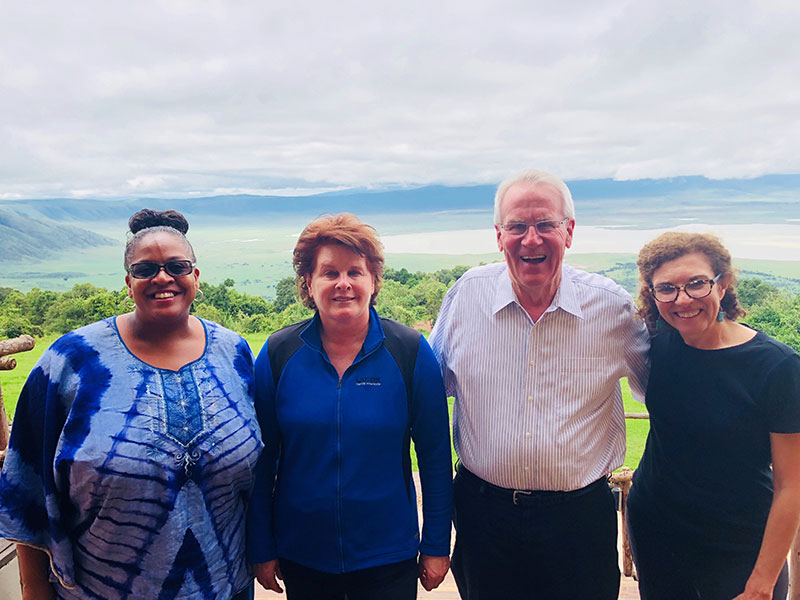Making the Impossible Possible: From Burundi to Guatemala
Posted on
May 29, 2018
 (from left) Shannon Márquez, Vice Provost of Global Health & International Development; Dana and David Dornsife; Ana Diez Roux, Dean, Dornsife School of Public Health
(from left) Shannon Márquez, Vice Provost of Global Health & International Development; Dana and David Dornsife; Ana Diez Roux, Dean, Dornsife School of Public Health
The last three weeks have been intense and packed with experiences, reflections, and the opportunity to learn from so many different people and places. First, I travelled to Rwanda, Burundi, Kenya, and Tanzania in the company of our generous benefactors Dana and David Dornsife, as well as Vice Provost Shannon Marquez, PhD, and many talented World Vision leaders and staff. Shortly after that I was in Antigua, Guatemala, where over 60 researchers and urbanists from all over Latin America and the United States came together as part of the biannual SALURBAL (Salud Urbana en America Latina/Urban Health in Latin America) meeting.
In Africa, our focus was on visiting various WASH (Water Sanitation and Hygiene) projects. We met with families to learn about the many challenges they face in accessing even very basic water and sanitation services. In many cases the stories were heartbreaking. How can we live in a world where there is so much injustice? But many of the community members we spoke to were inspiring in their focus and determination to make their lives better. They fight every day to carve out a decent living for themselves and their families from the resources they have, but it is immensely difficult because of the structures, forces, and longstanding historical factors in place that have created the inequities that we see today.
In Guatemala, I was part of a team whose goal it is to make the large and growing cities of Latin America healthier, more equitable, and environmentally sustainable. The challenges are enormous: 19 of the 30 most economically unequal cities in the world are in Latin America. And they are growing and sprawling, subject to economic and social forces that increase air pollution, promote the consumption of unhealthy processed foods, and magnify inequities and violence. How can we bring multiple sectors together to govern and manage cities so that they are healthier and promote equity?
At first glance, Africa and Latin America may appear very different. And in many ways they are. Africa remains much less urbanized than Latin America, although that is changing rapidly. The histories and cultures are very different and yet the native inhabitants of both regions have suffered the consequences of colonialism and a global economic order that extracted people and resources. Both regions have also witnessed major social conflicts and authoritarian regimes. But intermingled with all this, and over the course of history, they have lived through examples of hope and possibility, of what life in the region could aspire to. And both are home to incredible cultural richness and diversity.
In many ways, the health challenges faced by both regions are the same: the continuing threat of old and emerging infectious diseases (like Zika or Ebola) superimposed on a growing epidemic of non-communicable diseases (hypertension, diabetes), driven by societal changes in the way food is produced, consumed and advertised, and by increasing reliance on motorized travel with consequences for physical activity and air pollution. All this is linked to persistent and even growing social inequalities and spatial segregation creating enormous differences in the physical and social environments in which people live and work.
Water and sanitation access is a critical problem in many rural areas of both regions, but it is also a major problem in growing urban slums and informal settlements. Changes in food production and distribution and the increasing availability of processed foods and sugar-sweetened beverages (even in places with no access to water!) also characterize both regions. And last but not least, violence and social conflicts rooted in inequality are pervasive.
As public health professionals what can we do? Certainly the problems are much bigger than health, but the goal of improving health provides opportunities for action. And today the increasing emphasis on linking improved population health to environmental sustainability makes explicit the fact that our health and the “health” of our planet are inextricably linked. As public health professionals we have the responsibility to first consistently and rigorously document the patterns in health and the factors that drive them. And then of course we have the responsibility to use this knowledge to spur and support action.
Achieving these goals may appear impossible. The data we rely on are messy and incomplete. Political structures are corrupt and unresponsive. The forces driving the economy are vast and often push toward unhealthy outcomes. But we have to start somewhere, whether it is bringing water to one household at a time or describing health inequities across hundreds of Latin American cities using imperfect data. As we say in the SALURBAL project, we are about “making the impossible possible.” A valiant woman we met in Burundi meant the same thing when she insisted in the face of our gentle questioning about sanitation that water was what they really needed. “Make it happen,” she said.
Now that I think about it, perhaps “making the impossible possible” is after all the theme that ties my recent trips to Africa and Latin America together.
Ana V. Diez Roux, MD, PhD, MPH
Dean and Distinguished Professor, Epidemiology, Dornsife School of Public Health